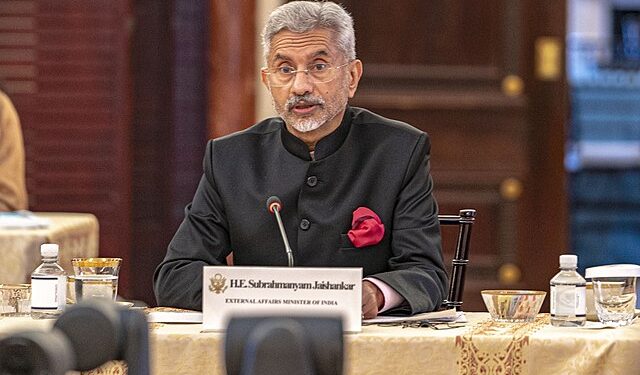A Controversial US Deportation Raises Concerns
The recent deportation of 104 Indian nationals from the United States has sparked a wave of controversy, drawing sharp reactions from political leaders, human rights activists, and the deportees themselves. The U.S. military aircraft, which landed in Amritsar, India, carrying the deportees, highlighted the growing concerns over the treatment of Indian immigrants facing deportation under strict U.S. immigration policies.
This development has prompted India’s External Affairs Minister (EAM) S. Jaishankar to address the issue in Parliament. He acknowledged the harrowing experiences shared by those who were sent back. He emphasized that the Indian government is engaging with the U.S. authorities to ensure the humane treatment of deported individuals in the future.
The Deportation Event: What Happened?
On February 5, 2025, a U.S. military aircraft carrying 104 deported Indian nationals, including 19 women and 13 minors, landed at Sri Guru Ramdas Ji International Airport, Amritsar. The deportees hailed from Punjab, Haryana, Gujarat, Maharashtra, and Uttar Pradesh, regions known for high migration rates to the U.S.
Upon arrival, they underwent detailed verification and questioning by immigration officials, Punjab Police, and intelligence agencies before being permitted to return to their respective towns and villages. The deportation was executed by U.S. Immigration and Customs Enforcement (ICE) as part of a broader crackdown on illegal immigrants.
For many deportees, this journey marked a painful end to their dreams of living and working in the United States. Several individuals had invested large sums of money in securing passage through illegal immigration networks, only to face arrests, detention, and eventual deportation.
Jaishankar’s Response: Addressing Public and Political Concerns
Amid growing concerns over the deportations, EAM S. Jaishankar addressed the issue in Rajya Sabha (India’s upper house of Parliament). His remarks provided a diplomatic yet firm stance on the situation, balancing India’s commitment to legal migration with the need to protect its citizens abroad.
Jaishankar confirmed that many deportees had shared harrowing accounts of their deportation process, including allegations of mistreatment and excessive restraints during transit. However, he clarified that the use of handcuffs and restraints is a standard deportation practice under U.S. immigration policies and not unique to Indian deportees.
He emphasized three key points:
- Deportation is not a new phenomenon – The U.S. has been deporting illegal immigrants, including Indians, for years.
- Standard Operating Procedures (SOPs) exist for deportations – The practice of using restraints has been in place since 2012.
- Women and children were not restrained – ICE confirmed that only adult male deportees were subjected to handcuffs and leg restraints.
Jaishankar reassured the Parliament that India is in continuous discussions with U.S. authorities to ensure fair treatment and proper handling of deported individuals.
Opposition’s Sharp Criticism and Protests
The deportation row has triggered sharp reactions from opposition parties, who have accused the Indian government of failing to protect its citizens. Lawmakers from the Indian National Congress (INC) and other parties have condemned the treatment of deportees, alleging that many were handcuffed and leg-chained throughout the 40-hour flight.
Prominent Congress leader Rahul Gandhi led a protest outside Parliament, criticizing the government’s inaction on the issue. Lawmakers symbolically wore handcuffs inside the Parliament chambers, demanding an official inquiry into the treatment of deported Indian nationals.
Congress MP Renuka Chowdhury termed the deportation process “inhumane and degrading”, while Gaurav Gogoi questioned why Indians were treated like criminals despite lacking serious charges. The opposition has demanded a full-scale diplomatic intervention to prevent similar incidents in the future.
Harrowing Experiences: Voices of the Deportees
For many deportees, the journey back home was one of humiliation, trauma, and financial ruin.
Jaspal Singh, a 36-year-old from Punjab, described his experience:
“We were treated like criminals. Handcuffs and leg chains remained on for the entire flight. We couldn’t move, eat properly, or even rest. It was worse than hell.”
Another deportee, Daler Singh from Gujarat, shared his ordeal:
“I spent $45,000 to reach the U.S. illegally through an agent. After weeks of travelling through different countries, I was detained and deported within three weeks. Now, I have nothing left.”
Many deportees had mortgaged land and sold property to fund their illegal migration to the U.S., leaving their families in financial distress upon their return.
Diplomatic Implications: US-India Relations and Future Migration Policies
The deportation incident occurs when India and the United States are actively discussing immigration policies. Prime Minister Narendra Modi is set to meet U.S. President Donald Trump in Washington in the coming weeks, where migration-related concerns are expected to feature prominently.
Key Issues in Bilateral Talks
- Ensuring humane treatment of deportees
- Strengthening legal migration pathways for skilled Indian workers
- Addressing concerns over mass deportations and their impact on Indo-US relations
The U.S. embassy in India reiterated that the deportations were conducted in line with American immigration laws. A spokesperson stated, “The U.S. is committed to enforcing its immigration laws and returning inadmissible individuals to their home countries safely and humanely.”
Future Policy Reforms: India’s Plan to Address Migration Issues
Recognizing the growing challenges related to illegal immigration, the Indian government is working on new legislative reforms. The Emigration (Overseas Mobility Facilitation and Welfare) Bill, 2024 aims to modernize migration laws, replacing the outdated Emigration Act of 1983.
Key Features of the Proposed Bill
- Promotes safe and legal overseas employment.
- Strengthens protections for Indian workers abroad.
- Expands Protector of Emigrants (PoE) offices in migration-prone states like Punjab and Uttar Pradesh.
- Introduces stricter anti-trafficking measures to prevent illegal immigration networks from exploiting job seekers.
With these measures, India hopes to reduce illegal migration risks and enhance employment opportunities abroad through proper legal channels.
The Larger Implications of the US Deportation Row
The deportation of 104 Indian nationals has ignited a broader conversation on illegal immigration, deportation ethics, and international human rights. While the U.S. maintains its right to deport undocumented migrants, India is pushing for greater protections for its citizens abroad.
As the Indo-US dialogue on migration continues, this incident is a stark reminder of the risks associated with illegal migration. Future policies must strike a balance between border security, legal migration, and the humane treatment of deported individuals.
With Prime Minister Modi’s upcoming visit to Washington, discussions on visa norms, skilled migration programs, and deportation procedures will be critical in shaping India-U.S. immigration relations.








